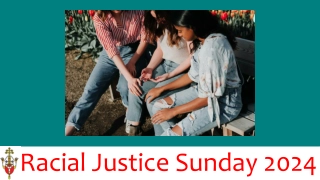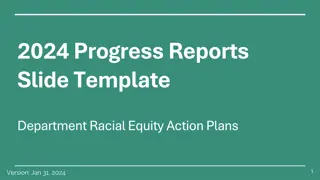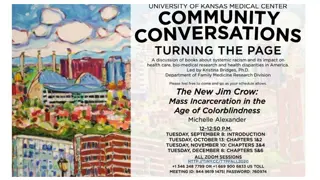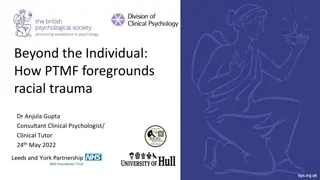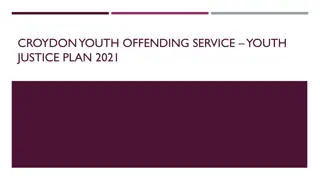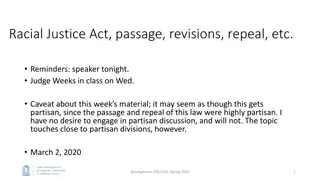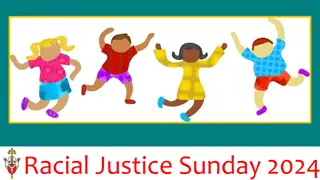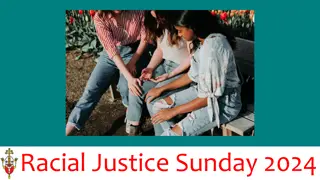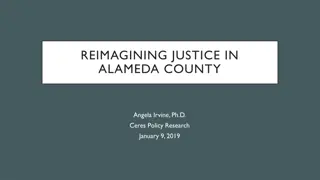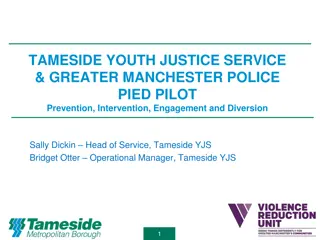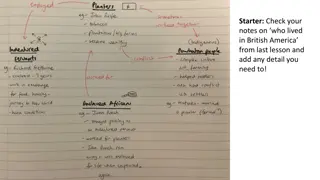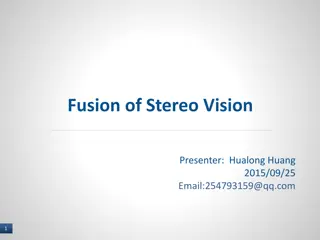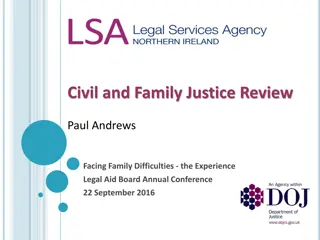Understanding Racial Disparity in Early Years and Youth Justice System
This presentation explores racial disparity affecting children in their formative years and within the youth justice system, highlighting systemic prejudices and inequalities. It includes data on various facets such as sport, school absence, stop-and-search, and homicides. The impact of COVID-19 on children's lives and the efforts to address these disparities are also discussed. Voices from the youth ambassador network shed light on experiences of injustice and the need for societal change.
Download Presentation

Please find below an Image/Link to download the presentation.
The content on the website is provided AS IS for your information and personal use only. It may not be sold, licensed, or shared on other websites without obtaining consent from the author. Download presentation by click this link. If you encounter any issues during the download, it is possible that the publisher has removed the file from their server.
E N D
Presentation Transcript
Understanding racial disparity How it affects children in their early years and within the youth justice system December 2021
Foreword from our youth ambassadors We asked our Youth Ambassador Network to share their views: Is society and the youth justice system fair? In my experience, the youth justice system is not fair. I have experienced racial injustice, being stopped and searched and being focussed on for no reason by the police. And it will be mainly because of my skin colour. Because we re all Black and we re walking down the street, it seems like we re in a gang. People look at us different. Because I m White, my main experience with the police is that I get treated like a victim because I m the only White person there.
Has there been any progress? More people are starting to listen, going out of their way to talk to young people, getting to know what they are going through and actually doing something about it. What do you think can improve? Set up events for the local police to get involved with the community. Services as a whole receiving community engagement training. I hope that in the future, the younger people of that time will be able to speak up and express themselves because many young people suffer in silence. The older generation actually need to sit down and listen to us. It s important to hear young people s voices because it s us young people who are going through these issues in our everyday lives.
Introduction We have produced this presentation to highlight the areas where racial disparity occurs, and show how, from an early age and within the youth justice system, there are systemic and institutional prejudices that result in some children not receiving equal treatment. This presentation covers data from various sources as well as from the youth justice annual statistics for 2019 to 2020. This year we have included additional data on sport and physical activity, absence from school, stop and search and homicides. Since March 2020, the COVID-19 pandemic has had an impact on the lives of everyone, particularly children. Their lifestyle, routine, mental health and wellbeing, education and employment have all been affected. Probably none more so than for those in contact with the youth justice system. Some of these children will have faced the added uncertainty of postponed court cases while others will have faced extra restrictions in custody. We couldn t ascribe a particular COVID-19 effect to the data in this presentation, but equally we couldn t rule it out and so this should be borne in mind as you read through it.
Introduction (continued) Data that shows the full impact of COVID-19 on the lives of children is only just starting to come through, however we have included data on the mortality rates for adults due to COVID-19, which gives valuable insight into the disparities present. Finally, we have provided information throughout this presentation on what the YJB is doing to tackle disproportionality. However, we can t change the system alone and we will continue to need the help of government departments, agencies and statutory functions.
Children in England and Wales Data from the 2011 Census provides a breakdown of the number of under in 18-year-olds in England and Wales by ethnicity. White, 79% (9.5 million) Black, 5% (567 thousand) Asian, 9% (1.1 million) Mixed, 5% (603 thousand) Other, 2% (211 thousand) Source: https://www.ethnicity-facts-figures.service.gov.uk/uk-population-by-ethnicity/demographics/age-groups/latest
The youth justice workforce As part of the YJB s Workforce Development Strategy we monitor the ethnic diversity of the youth offending team (YOT) workforce. Ethnic minorities in strategic leader roles made up 14% of the YOT workforce. This is a 2% rise on the previous year.
The youth justice workforce Composition of the youth offending team (YOT) workforce in 2019-20 Role Number of role holders from ethnic minorities 28 (out of 195) 108 (out of 607) 809 (out of 4,012) 138 (out of 770) 472 (out of 2,177) The YOT workforce (%) Strategic leader Operational manager Practitioner Administrative Referral Order Panel volunteer Other volunteer 14% 18% 20% 18% 22% 189 (out of 1,209) 16%
What we are doing We have recruited 12 participants onto the Elevate Programme. Elevate is a six-month mentoring programme designed to support the progression of middle managers from ethnic minorities (including White minorities) into strategic management - where they are currently under-represented. In general, children from ethnic minority backgrounds are over-represented at most stages of the youth justice system. In most cases, this is driven by the over- representation of children from Black, Mixed and Gypsy, Roma and Traveller backgrounds. It is therefore important that there are visible, positive role models in senior leadership positions within youth justice services. We developed Elevate with the Youth Justice Sector Improvement Partnership (YJSIP) following recommendations from the Youth Justice Workforce Development Council. The YJSIP has trained a highly skilled and experienced group of mentors and these individuals have offered to support the Elevate programme. Drawn from a range of both urban and rural settings in England and Wales, the Elevate mentors will provide a wealth of experience to share with Elevate participants and support the managers as they explore their future in strategic positions of leadership. Elevate started in October 2021
Expected development In England, 71% of 4 to 5-year-olds met the expected standard in development by the end of the 2018 to 2019 school year. Percentage of children achieving expected development: White: 72% Black: 68% Asian: 69% Mixed: 72% Chinese: 76% Other: 63% Sources: https://www.gov.uk/government/statistics/early-years-foundation-stage-profile-results-2018-to-2019
Expected development (look closer) For the end of the 2018 to 2019 school year, children from an Indian background, within the Asian group, were most likely to meet the expected standard with 78% doing so. Children from Gypsy and Roma backgrounds, within the White group, were least likely at 34%. Number and percentage of children achieving expected development, 2019: Ethnicity White White British Irish Traveller of Irish heritage Gypsy/Roma % 72 73 74 39 Number 459,403 409,675 1,551 665 34 2,151 Source: https://www.ethnicity-facts-figures.service.gov.uk/uk-population-by- ethnicity/demographics/people-living-in-deprived-neighbourhoods/latest#overall-most-deprived- 10-of-neighbourhoods-by-ethnicity
Expected development (look closer) Ethnicity Any other White background Mixed White and Black Caribbean White and Black African White and Asian Any other Mixed background % 66 Number 45,361 72 69 41,685 9,814 71 5,777 75 73 10,305 15,789 Source: https://www.ethnicity-facts-figures.service.gov.uk/uk-population-by- ethnicity/demographics/people-living-in-deprived-neighbourhoods/latest#overall-most-deprived- 10-of-neighbourhoods-by-ethnicity
Expected development (look closer) Ethnicity Asian Indian Pakistani Bangladeshi Any other Asian background Black Black Caribbean Black African Any other Black background Source: https://www.ethnicity-facts-figures.service.gov.uk/uk-population-by- ethnicity/demographics/people-living-in-deprived-neighbourhoods/latest#overall-most-deprived- 10-of-neighbourhoods-by-ethnicity % 69 78 64 67 69 Number 69,185 20,363 27,141 10,212 11,469 68 68 68 66 31,136 5,270 21,432 4,434
Expected development (look closer) Ethnicity Chinese Any other ethnic group Unclassified % 76 63 Number 3,002 12,048 58 22,487 Source: https://www.ethnicity-facts-figures.service.gov.uk/uk-population-by- ethnicity/demographics/people-living-in-deprived-neighbourhoods/latest#overall-most-deprived- 10-of-neighbourhoods-by-ethnicity
Expected development For the end of the 2018 to 2019 school year, children from an Indian background, within the Asian group, were most likely to meet the expected standard with 78% doing so. Children from Gypsy and Roma backgrounds, within the White group, were least likely at 34% Percentage of children achieving expected development: Sources: https://www.gov.uk/government/statistics/early-years-foundation-stage-profile-results-2018-to-2019
Child in need In England, over the last five years there has been a gradual decline in the proportion of children in need that were White, from 75% in 2015 to 72% in 2020. In contrast, there have been slight increases in the percentage whose ethnicity was Mixed (from 8% to 9%) or Black (8% to 9%) and no change in the percentage of those whose ethnicity was Asian (7%). Children in need are defined in law as children who are aged under 18 and need local authority services to achieve or maintain a reasonable standard of health or development. They also need local authority services to prevent significant or further harm to their health or development. Source: https://www.gov.uk/government/statistics/characteristics-of-children-in-need-2019-to-2020
Care and support In Wales, for the year ending 31 March 2020, out of all children for whom ethnicity was known, 92% of children receiving care and support (on the child protection register but not looked-after) were White, 3% were Mixed, 2% were Asian and 1% were Black. Source: https://gov.wales/wales-children-receiving-care-and-support-census
Children looked-after In England, there were 78,150 children looked-after (in care) on 31 March 2019, compared with 69,470 in 2015. When compared to the general population of under-18-year-olds (data from the 2011 Census): White children (79%) were less likely to be in care (74%) and more likely to be adopted (83%). Black children (5%) were more likely to be in care (8%) and less likely to be adopted (2%). Asian children (10%) were less likely to be in care (4%) and less likely to be adopted (1%). Mixed ethnicity children (5%) were more likely to be in care (10%) and more likely to be adopted (11%). Source: https://www.gov.uk/government/statistics/children-looked-after-in-england-including-adoption-2019-to-2020
Children looked-after In Wales, the majority of children looked-after are White (92%). 4% were mixed, 2% were Asian and 1% were Black or Black British. The proportion of children who were looked after has increased for all ethnic groups in the last year, this increase was greatest for Asian children at 17% (however, smaller cohorts are more susceptible to fluctuations than larger ones) and lowest for White children at 3%. White children (93%) were less likely to be in care (91%) Black children (1%) were more likely to be in care (2%) Asian children (3%) were less likely to be in care (2%) Mixed ethnicity children (2%) were more likely to be in care (3%). Source: https://gov.wales/wales-children-receiving-care-and-support-census
Deprivation Out of all people (not just children), those from an Asian background (15.7%) were the most likely out of all ethnic groups to live in the most deprived neighbourhoods, followed by Black people (15.2%). People from Pakistani or Bangladeshi backgrounds, within the Asian group, were the most likely to live in deprived areas at 31% and 19% respectively. People living in the most deprived 10% of neighbourhoods, by ethnicity: White: 9% Black: 15% Asian: 16% Mixed: 13% Other: 13% Source: https://www.ethnicity-facts-figures.service.gov.uk/uk-population-by- ethnicity/demographics/people-living-in-deprived-neighbourhoods/latest#overall-most-deprived- 10-of-neighbourhoods-by-ethnicity
Deprivation (look closer) People living in the most deprived 10% of neighbourhoods, by ethnicity: Ethnicity All Asian Bangladeshi Chinese Indian Pakistani Asian other Black % 9.9 15.7 19.3 8.4 7.6 31.1 9.9 15.2 Number 5,249,400 649,079 84,362 32,046 105,993 345,858 80,820 281,554 Source: https://www.ethnicity-facts-figures.service.gov.uk/uk-population-by- ethnicity/demographics/people-living-in-deprived-neighbourhoods/latest#overall-most-deprived- 10-of-neighbourhoods-by-ethnicity
Deprivation (look closer) People living in the most deprived 10% of neighbourhoods, by ethnicity: Ethnicity Black African Black Caribbean Black other Mixed Mixed White/Asian Mixed White/Black African Mixed White/Black Caribbean % 15.6 14.1 16.6 13.2 10.1 13.7 Number 152,096 83,463 45,995 157,100 33,704 22,143 17.4 72,293 Source: https://www.ethnicity-facts-figures.service.gov.uk/uk-population-by- ethnicity/demographics/people-living-in-deprived-neighbourhoods/latest#overall-most-deprived- 10-of-neighbourhoods-by-ethnicity
Deprivation (look closer) People living in the most deprived 10% of neighbourhoods, by ethnicity: Ethnicity Mixed other White White British White Irish White Gypsy/Traveller 11.7 White other Other Arab Any other Source: https://www.ethnicity-facts-figures.service.gov.uk/uk-population-by- ethnicity/demographics/people-living-in-deprived-neighbourhoods/latest#overall-most-deprived- 10-of-neighbourhoods-by-ethnicity % 10.2 9 9.1 8.1 Number 28,960 4,088,373 3,841,600 42,014 6,450 198,309 73,294 34,271 39,023 8.2 13.4 15.5 11.9
Social housing In England, for 2016/17 and 2018/19, 17% of households (3.9 million) in England rented their home from a local authority or housing association. Out of the main ethnic groups, the highest proportion of those renting were from Black households and within that group Black African were the highest at 44%. The proportion of those living in rented social housing: White: 16% Black: 42% Asian: 14% Mixed: 29% Other: 26% Source: https://www.ethnicity-facts-figures.service.gov.uk/housing/social-housing/renting-from-a- local-authority-or-housing-association-social-housing/latest#by-ethnicity
Home Ownership While White British households had a higher proportion of home ownership than most ethnic minority households, the highest proportion was among Indian households at 74%. Mixed White and Asian households had a similar proportion of home ownership to White British households (at 70%). Households in the Black African (20%) and Arab (17%) ethnic groups had the lowest proportion of home ownership. Source: https://www.gov.uk/government/statistics/english-housing-survey-2017-to-2018-home-ownership
Persistent low income Children in Asian (26%) and Black (21%) households in the UK were more likely to live in persistent low income than those in White (10%) households. Households with persistent low income (less than 60% of the average UK income for 3 out of 4 years): White: 10% Black: 21% Asian: 26% Mixed: 0% (Data withheld because a small sample size makes it unreliable) White Other: 12% Sources: https://www.gov.uk/government/statistics/income-dynamics-2016-to-2017 https://www.ethnicity-facts-figures.service.gov.uk/work-pay-and-benefits/pay-and-income/low- income/latest#by-ethnicity-and-age-group-after-housing-costs
Never worked In England, compared to the general population, people from Asian and Black groups were about twice as likely to have never worked or be long term unemployed (at 18% and 6% respectively). This is higher than their share of the general population (8% and 3% respectively). Sources: https://www.ons.gov.uk/census/2011census https://www.ethnicity-facts-figures.service.gov.uk/uk-population-by- ethnicity/demographics/socioeconomic-status/latest
Legal aid Out of all people in England and Wales, the highest proportion of those receiving legal aid were White. Nevertheless, the proportion of those receiving legal aid from ethnic minorities was much larger than in the general population. This may reflect the fact that controlled legal representation for immigration is included in these figures. The proportion of legal aid by ethnicity: White: 40% Ethnic minorities: 25% Unknown: 35% Source: https://assets.publishing.service.gov.uk/government/uploads/system/uploads/attachment_data /file/895088/legal-aid-statistics-bulletin-jan-mar-2020.pdf
Special educational needs In England, the number of pupils with special educational needs (SEN) in January 2020 was one million. This represents 12% of the total pupil population. Source: https://explore-education-statistics.service.gov.uk/find-statistics/special-educational-needs-in- england#releaseHeadlines-tables
Proportion of pupils with SEN Of the main ethnic groups, White children had the highest percentage of SEN at 13%. White: 13% Black: 12% Mixed: 12% Asian: 9% Chinese: 5% Other: 10% Out of all ethnicities, special educational needs were most prevalent in Travellers of Irish heritage and Gypsy/Roma pupils at 24% and 23% respectively. Source: https://explore-education-statistics.service.gov.uk/find-statistics/special-educational-needs-in- england#releaseHeadlines-tables
SEN (look closer) Percentage of pupils with special educational needs (SEN), by ethnicity, 2020/21: Ethnicity White - Traveller of Irish heritage White Gypsy/Roma Black Black Caribbean Mixed White and Black Caribbean White White British White - Irish Black any other Black background Mixed White and Black African Asian - Pakistani % 24 23 16 15 13 13 12 12 12 Source: https://explore-education-statistics.service.gov.uk/find-statistics/special-educational- needs-in-england#releaseHeadlines-tables
SEN (look closer) Percentage of pupils with special educational needs (SEN), by ethnicity, 2020/21: Ethnicity Mixed any other Mixed background Black Black African Asian - Bangladeshi Mixed - White and Asian White any other White background Asian any other Asian background Asian - Indian % 11 11 10 9 9 8 6 Source: https://explore-education-statistics.service.gov.uk/find-statistics/special-educational- needs-in-england#releaseHeadlines-tables
Key stage 2 In England, of the main ethnic groups, pupils from Chinese backgrounds were most likely to meet expected standards (80%). Pupils from Other ethnicities were the least likely (61%). Key stage 2 attainment in England, percentage of pupils reaching the expected standard, 2018/19 (key stage 2 assessments were suspended for 2019/20 due to the pandemic.): White: 64% Black: 63% Asian: 68% Mixed: 66% Chinese: 82% Other: 61% Source: https://www.gov.uk/government/statistics/key-stage-2-and-multi-academy-trust-performance- 2018-revised
Key stage 2 In Wales, of the main ethnic groups, White Gypsy/Roma pupils (63%) and Irish Traveller (61%) were the least likely to meet the expected standard. Percentage of pupils in Wales achieving expected level in maths, English, science and core subject indicator, by ethnicity, 2017 to 2019: White: 89% Black: 87% Asian: 90% Mixed: 90% Chinese: 96% Other: 82% Source: https://statswales.gov.wales/Catalogue/Education-and-Skills/Schools-and- Teachers/Examinations-and-Assessments/Key-Stage-2
Key stage 4 In England, of the main ethnic groups, pupils from Chinese backgrounds were most likely to achieve a grade 5 or above in English and maths (80%). Black pupils were the least likely (46%). Percentage of pupils at Key Stage 4 achieving grade 5 or above in English and mathematics GCSEs by ethnicity, 2019/20: White: 49% Black: 46% Asian: 58% Mixed: 50% Chinese: 80% Source: https://www.gov.uk/government/statistics/key-stage-4-and-multi-academy-trust-performance- 2018-revised
Key stage 4 In Wales, of the main ethnic groups, pupils from Chinese backgrounds were most likely to achieve Level 1, the equivalent to 5 GCSEs. Out of all ethnicities, Gypsy/Roma pupils were the least likely (75%). Percentage of pupils who achieved the Level 1 threshold (a volume of qualifications equivalent to 5 GCSEs at grade A*-G): White: 96% Black: 97% Asian: 98% Mixed: 96% Chinese: 100% Other: 96% Source: https://statswales.gov.wales/Catalogue/Education-and-Skills/Schools-and- Teachers/Examinations-and-Assessments/Key-Stage-4/ks4indicators-by-year-ethnicity
Looking closer at key stage 4 In England, within the White ethnic group, only 8% of Gypsy Roma children achieved a grade 5 or above in English or maths. Traveller of Irish heritage children also fared poorly at 20%. While Black pupils as a whole were the least likely to achieve a grade 5 or above in English and maths (46%), pupils from Black African backgrounds (51%) slightly surpassed both the White (49%) and Mixed (50%) ethnic groups as a whole. Pupils from Black Caribbean backgrounds didn't fare as well at 35%. Source: https://www.gov.uk/government/statistics/key-stage-4-and-multi-academy-trust-performance- 2018-revised
Permanent exclusions In England, within the White ethnic group, Gypsy, Roma and Traveller pupils had the highest permanent school exclusion rates in the 2018 to 2019 school year. Gypsy and Roma pupils made up 0.39%, or 39 permanent exclusions per 10,000 pupils. Mixed White/Black Caribbean and Black Caribbean pupils were over twice as likely to be permanently excluded as White British pupils in the 2018/19 (school year). Source: https://www.ethnicity-facts-figures.service.gov.uk/education-skills-and-training/absence-and- exclusions/pupil-exclusions/latest#main-facts-and-figures
Permanent exclusions In Wales, in 2018/19 pupils from a White ethnic background had the highest rate of fixed term exclusions (5 days or less), whilst pupils with a Chinese or Chinese British background have the lowest rates of exclusion. Source: https://gov.wales/permanent-and-fixed-term-exclusions-schools-september-2018-august-2019
Pupil absence In England, Traveller of Irish heritage pupils and Gypsy/Roma pupils had the highest overall absence rates at 17.0% and 13.0% respectively. These groups also had the highest rates in the full 2018/19 academic year, at 18.0% and 12.6% respectively. Pupil absence in schools in England by ethnicity: autumn term, 2019/20: White: 5.1 Black: 3.5 Asian: 4.3 Mixed: 5.1 Other: 4.3 Gypsy/Roma: 13 Traveller: 17 Source: https://explore-education-statistics.service.gov.uk/find-statistics/pupil-absence-in-schools-in- england-autumn-term
Pupil absence In Wales, overall absence is highest for White pupils and particularly among those from a Gypsy or Traveller background. Pupil absence in secondary schools in 2018/19 school year: White: 6.3 Black: 3.3 Asian: 4.2 Mixed: 6.0 Other: 3.7 Chinese: 2.0 Gypsy: 17.0 Traveller: 14.8 Source: https://statswales.gov.wales/Catalogue/Education-and-Skills/Schools-and- Teachers/Absenteeism
Education, apprenticeships or employment Over 90% of pupils from nearly every ethnic group went into education, apprenticeships or employment. The exceptions were Gypsy, Roma and Traveller pupils. Proportion of pupils that went into education, apprenticeships or employment for at least 2 terms after finishing their GCSEs (or equivalent) in 2018/19: Gypsy/Roma: 65% Irish Traveller: 65% Source: https://www.gov.uk/government/collections/statistics-destinations
Higher education Between 2006 and 2020, Black pupils had the biggest entry rate increase out of all ethnic groups in the UK, from 21.6% to 47.5%. White pupils had the lowest entry rate between 2007 (22.2%) and 2020 (32.6%). Source: https://www.ethnicity-facts-figures.service.gov.uk/education-skills-and-training/higher- education/entry-rates-into-higher-education/latest#main-facts-and-figures
What we are doing In the past year we: Held a roundtable employability event with over 120 participants from other government departments, employment groups, employers, children and young adults which considered how we could support children into meaningful employment. Continued to work with the Department for Work and Pensions to pilot a Mentoring Circles programme for 16 and 17-year-old's in two London boroughs. We have agreement to work with a number of employers to develop the pilot programme including Fujitsu and the Financial Times. Provided funding from the Ministry of Justice as part of the Stewardship fund based on Lammy Recommendation 31 'to involve smaller organisations with a particular focus on Black, Asian and minority ethnic issues. Lewisham Youth Offending Service and Power The Fight delivered the 'cultural responses to trauma and serious violence' project supporting two mainstream schools and one alternative provision, by delivering culturally sensitive interventions to children, school staff and parents/carers they supported to build resilience and improve children's mental health and reduce their vulnerability to involvement in serious violence
Mental health: prevalence The nature of mental health inequality is complex, and affected by factors such as social and economic inequalities, racism and discrimination, stigma and the cultural appropriateness of treatments. Data on children s contact with mental health services in the UK is limited. We cover this subject further in our notes on the data. A follow up to the 2017 'mental health and young people survey' explored the mental health of 5 to 19-year-olds in England during the COVID-19 pandemic. In 2020, 18.8% of White children (5 to 16-year-olds) had a probable* mental disorder, compared with 7.5% of children from ethnic minorities (excluding White minoritie * according to an NHS survey for children and parents that assessed different aspects of mental health, classified as either unlikely , possible or probable .s). Sources: https://digital.nhs.uk/data-and-information/publications/statistical/mental-health-of-children- and-young-people-in-england/2020-wave-1-follow-up https://files.digital.nhs.uk/AF/AECD6B/mhcyp_2020_rep_v2.pdf
Mental health: prevalence To measure children's general wellbeing, a non-representative survey by the Children's Commissioner for Wales in May 2020 indicated that 7 to 11-year-olds from ethnic minority backgrounds were significantly less likely than White Welsh or British children to say they were 'happy most of the time' at 60% and 67% respectively. Sources: https://www.childcomwales.org.uk/wp- content/uploads/2020/09/Briefing_Report_E_2020_FINAL.pdf https://gov.wales/sites/default/files/statistics-and-research/2020-03/counselling-children-and- young-people-september-2018-august-2019-570.pdf
Mental health: rate of detentions In the year to March 2020, Black people (adults and children) were more than 4 times as likely as White people to be detained under the Mental Health Act 321.7 detentions per 100,000 people, compared with 73.4 per 100,000 people. Sources: https://www.ethnicity-facts-figures.service.gov.uk/health/mental-health/detentions-under-the- mental-health-act/latest


